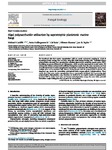Algal polysaccharide utilisation by saprotrophic planktonic marine fungi
| dc.contributor.author | Cunliffe, Michael | |
| dc.contributor.author | Hollingsworth, A | |
| dc.contributor.author | Bain, C | |
| dc.contributor.author | Sharma, Vikram | |
| dc.contributor.author | Taylor, JD | |
| dc.date.accessioned | 2017-12-08T17:02:58Z | |
| dc.date.issued | 2017-12 | |
| dc.identifier.issn | 1754-5048 | |
| dc.identifier.issn | 1878-0083 | |
| dc.identifier.uri | http://hdl.handle.net/10026.1/10392 | |
| dc.description.abstract |
© 2017 Elsevier Ltd and British Mycological Society. The functional roles that marine mycoplankton fulfil are poorly understood, resulting in a lack of knowledge of their ecology. Here we show, using DNA Stable Isotope Probing with 13 C-labelled diatom polysaccharide microgels, that mycoplankton assimilate algal-derived particulate organic carbon (POC), identifying two genera, Malassezia and Cladosporium, which are active saprotrophs in coastal waters. We subsequently isolated polysaccharide-utilising Cladosporium strains from the same ecosystem and that are well-represented in marine mycoplankton assemblages. At the study site, Cladosporium occurs across multiple years and is associated with diatoms. During growth with the polysaccharide laminarin, Cladosporium spp. secrete the extracellular carbohydrate-active enzyme glucan 1,3-β-glucosidase. These results show that some marine mycoplankton have a saprotrophic functional role in processing algal polysaccharides. Mycoplankton may, therefore, be involved in the trophic transfer of phytoplankton produced POC in marine food webs, and because bacterioplankton occupy the same niche, potential interactions maybe taking place that are yet to be characterised. | |
| dc.format.extent | 135-138 | |
| dc.language | en | |
| dc.language.iso | en | |
| dc.publisher | Elsevier | |
| dc.subject | Marine fungi | |
| dc.subject | Mycoplankton | |
| dc.subject | Saprotrophy | |
| dc.subject | Algal polysaccharides | |
| dc.title | Algal polysaccharide utilisation by saprotrophic planktonic marine fungi | |
| dc.type | journal-article | |
| dc.type | Journal Article | |
| plymouth.author-url | https://www.webofscience.com/api/gateway?GWVersion=2&SrcApp=PARTNER_APP&SrcAuth=LinksAMR&KeyUT=WOS:000417009400015&DestLinkType=FullRecord&DestApp=ALL_WOS&UsrCustomerID=11bb513d99f797142bcfeffcc58ea008 | |
| plymouth.volume | 30 | |
| plymouth.publication-status | Published | |
| plymouth.journal | Fungal Ecology | |
| dc.identifier.doi | 10.1016/j.funeco.2017.08.009 | |
| plymouth.organisational-group | /Plymouth | |
| plymouth.organisational-group | /Plymouth/Faculty of Health | |
| plymouth.organisational-group | /Plymouth/Faculty of Health/School of Biomedical Sciences | |
| plymouth.organisational-group | /Plymouth/Faculty of Science and Engineering | |
| plymouth.organisational-group | /Plymouth/Faculty of Science and Engineering/School of Biological and Marine Sciences | |
| plymouth.organisational-group | /Plymouth/REF 2021 Researchers by UoA | |
| plymouth.organisational-group | /Plymouth/REF 2021 Researchers by UoA/UoA01 Clinical Medicine | |
| plymouth.organisational-group | /Plymouth/REF 2021 Researchers by UoA/UoA07 Earth Systems and Environmental Sciences | |
| plymouth.organisational-group | /Plymouth/Research Groups | |
| plymouth.organisational-group | /Plymouth/Research Groups/Institute of Translational and Stratified Medicine (ITSMED) | |
| plymouth.organisational-group | /Plymouth/Research Groups/Institute of Translational and Stratified Medicine (ITSMED)/CBR | |
| plymouth.organisational-group | /Plymouth/Users by role | |
| plymouth.organisational-group | /Plymouth/Users by role/Academics | |
| dcterms.dateAccepted | 2017-08-30 | |
| dc.rights.embargodate | 2018-10-10 | |
| dc.identifier.eissn | 1878-0083 | |
| dc.rights.embargoperiod | Not known | |
| rioxxterms.versionofrecord | 10.1016/j.funeco.2017.08.009 | |
| rioxxterms.licenseref.uri | http://www.rioxx.net/licenses/all-rights-reserved | |
| rioxxterms.licenseref.startdate | 2017-12 | |
| rioxxterms.type | Journal Article/Review |


